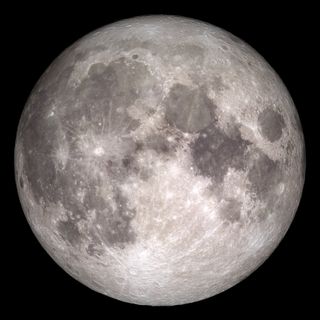US Space Force has new guidelines for working at and around the moon
A new report educates military space professionals about the cislunar region.

The U.S. Space Force has a new primer for activities beyond Earth orbit amid increased NASA and international interest in moon exploration.
A report published last Wednesday (June 23) by the Air Force Research Laboratory suggests that military officials should prepare for "cislunar space," which is the zone roughly comprising the moon and the region around it. The Space Force, as the space service military branch of the United States, would presumably make up much of the report's target audience.
The moon is already a destination of note in the civilian sector. NASA, via its Artemis program, aims to put astronauts on the lunar surface just a few years from now, and nearly a dozen countries have joined the agency's broader moon exploration effort under the Artemis Accords.
Related: Is Earth-moon space the US military's new high ground?
Meanwhile, NASA's Commercial Lunar Payload Services program will use private landers and rovers to put scientific hardware on the moon in the coming years to assess lunar resources for long-term settlement and scientific investigation.
The new report, which you can read here, states that it is "targeted at military space professionals who will answer the call to develop plans, capabilities, expertise and operational concepts" in cislunar space, given ongoing civilian interest.
The document largely concerns itself with technical matters such as challenges in observation, advantages and disadvantages of different sensor types and locations, and best practices for spacecraft trajectories in cislunar space.
Get the Space.com Newsletter
Breaking space news, the latest updates on rocket launches, skywatching events and more!
Notably, cislunar space is subject to gravitational influences from Earth, the sun and the moon and is largely unstable aside from relatively small zones of gravitational stability between the large bodies known as Lagrange points. (NASA's forthcoming James Webb Space Telescope, for example, will operate at a Lagrange point between the Earth and the sun.)
Col. Eric Felt, the director of AFRL's space vehicles directorate, said in a SpaceNews report that the document aims to "educate and inspire" due to the "unique challenges" of operating beyond Earth orbit. This recent military cislunar push is not quite new, however, because this zone was under discussion in 2018 under the presidential administration of Donald Trump, just before the U.S. Space Force was officially established in late 2019.
In a Space.com interview in 2018, military scholar Everett Dolman framed the military interest in cislunar space as a movement rooted in history, as previous British and U.S. imperial ventures into international waters also came with increased activity in the naval sector. Those earlier military efforts were broad in scope, including activities such as protecting civilians from pirates and raiders and natural threats such as extreme weather.
"Historically, as the commons become commercially important, it is not the military that pushes for presence there, it is the vested interests desiring protection that pull it in," said Dolman, a professor of comparative military studies at the U.S. Air Force's School of Advanced Air and Space Studies at the Air University, headquartered at Maxwell Air Force Base in Alabama.
Discussions have been ongoing since then. Another aspect of military presence in cislunar space could be protection of trade routes and communication lines, according to industry discussions in 2019. This protection could be even more key as cislunar space, rather than geosynchronous orbit, becomes the new "high ground" of human activity, officials said at the time. And earlier in 2021, the U.S. military picked three companies to test nuclear propulsion in cislunar space.
Follow Elizabeth Howell on Twitter @howellspace. Follow us on Twitter @Spacedotcom and on Facebook.
Join our Space Forums to keep talking space on the latest missions, night sky and more! And if you have a news tip, correction or comment, let us know at: community@space.com.

Elizabeth Howell (she/her), Ph.D., is a staff writer in the spaceflight channel since 2022 covering diversity, education and gaming as well. She was contributing writer for Space.com for 10 years before joining full-time. Elizabeth's reporting includes multiple exclusives with the White House and Office of the Vice-President of the United States, an exclusive conversation with aspiring space tourist (and NSYNC bassist) Lance Bass, speaking several times with the International Space Station, witnessing five human spaceflight launches on two continents, flying parabolic, working inside a spacesuit, and participating in a simulated Mars mission. Her latest book, "Why Am I Taller?", is co-written with astronaut Dave Williams. Elizabeth holds a Ph.D. and M.Sc. in Space Studies from the University of North Dakota, a Bachelor of Journalism from Canada's Carleton University and a Bachelor of History from Canada's Athabasca University. Elizabeth is also a post-secondary instructor in communications and science at several institutions since 2015; her experience includes developing and teaching an astronomy course at Canada's Algonquin College (with Indigenous content as well) to more than 1,000 students since 2020. Elizabeth first got interested in space after watching the movie Apollo 13 in 1996, and still wants to be an astronaut someday. Mastodon: https://qoto.org/@howellspace
